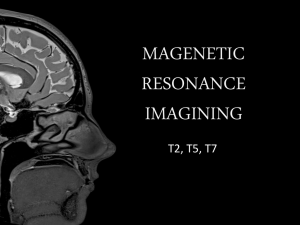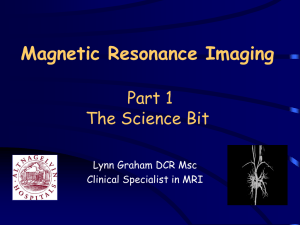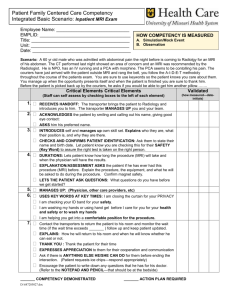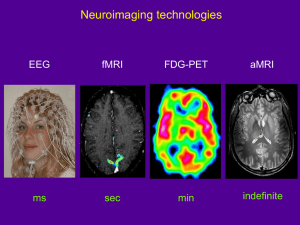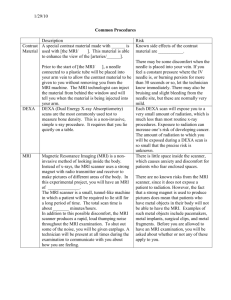Scientific Report
advertisement
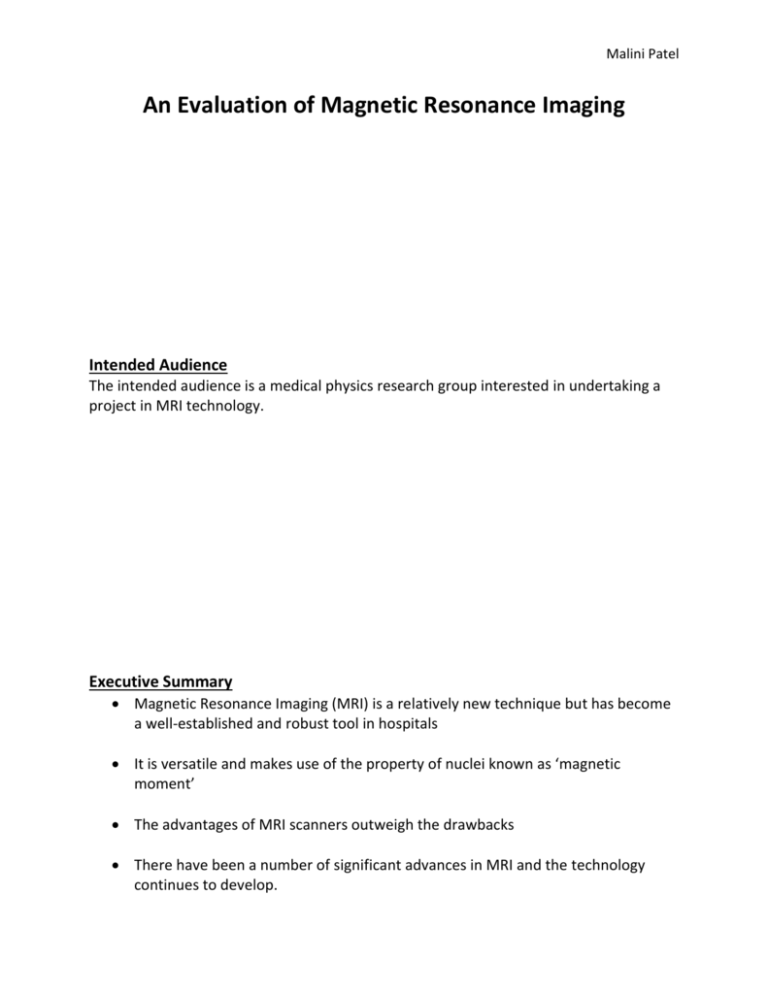
Malini Patel An Evaluation of Magnetic Resonance Imaging Intended Audience The intended audience is a medical physics research group interested in undertaking a project in MRI technology. Executive Summary Magnetic Resonance Imaging (MRI) is a relatively new technique but has become a well-established and robust tool in hospitals It is versatile and makes use of the property of nuclei known as ‘magnetic moment’ The advantages of MRI scanners outweigh the drawbacks There have been a number of significant advances in MRI and the technology continues to develop. Malini Patel Introduction MRI stands for ‘Magnetic Resonance Imaging’. It has only been in mainstream use since the 1980’s. MRI Scanners are versatile and have also been very successful in the field of diagnosis. How they work The core components of an MRI scanner are the magnets; namely the ‘primary magnet’ and the ‘gradient magnets’. The primary magnet is used to produce a strong and uniform magnetic field. It commonly varies in strength from 0.5 tesla to 3.0 tesla and so is extremely powerful. Most MRI scanners use superconducting magnets (solenoids immersed in liquid helium). The image quality of the scanner is dependant upon the strength of the magnet, and so superconducting magnets ensure a better visual image. The hydrogen atom plays an important part in the MRI process. All atoms produce a small magnetic moment due to the negatively charged protons orbiting the positive nucleus, as well as the spinning charge of the nucleus itself. Normally these moments occur in random directions (fig.1) meaning that there is no fixed orientation and no resultant magnetic field. However when nuclei are placed in a strong external magnetic field their magnetic moments tend to align with the direction of the external field (fig.2). The hydrogen atom is ideal for MRI scans firstly because it is abundant in the human body and secondly because it has a large magnetic moment meaning it has a strong tendency to align with an external field. The hydrogen nucleus consists of a single proton with a spin quantum number I = ½. In this case according to the laws of quantum mechanics two discrete energy levels (2I +1) are created; a higher energy level where the magnetic moment is directed opposite to the external magnetic field, and a lower level in which the moment is in the same direction as the magnetic field. In an MRI scanner, the hydrogen atoms in a patient’s body will align to either their feet or head. Gradient magnets, which are much smaller and weaker than the primary magnet, are used to create a variable, local field. They allow the magnetic field to be altered very precisely and help to create image ‘slices’ by focusing on a specific part of the body. A coil is used to apply a pulse towards the area of the body being examined. These pulses are of radio frequency and are specific to hydrogen. The energy transmitted by the pulses acts to tip the hydrogen atoms out of alignment with the primary magnetic field i.e. from a longitudinal plane to a transverse plane (fig.3), and also causes them to precess with a particular frequency. This transition requires a pulse of a specific resonant frequency called the Lamour frequency which is dependent on the type of tissue being Malini Patel examined and the strength of the primary magnet. The pulses are then stopped and the atoms begin to return to their natural alignment. By doing so, they release their excess energy (fig.4) which is picked up in the form of a signal by the coil and sent to a computer. The data is processed using the Fourier Transformation and turned into an image. Figure 1 Figure 3 Figure 2 Figure 4 Advantages and Disadvantages Major drawbacks of MRI scanners are that they are very expensive to purchase and also require experienced technicians to operate them. Moreover they cause a large amount of loud noise, and many patients may feel claustrophobic inside the scanner. Furthermore some patients are restricted from having scans due to devices such a pacemakers. The quality of the resultant image depends on the patient being still for long amounts of time and the scans can be distorted very easily. From a medical perspective the spatial resolution is not as good as other methods and in addition to this MRI scans are not suited to the evaluation of calcium bone cortex and are less effective at seeing air in the lungs. On the other hand, however a big advantage of MRI is that is uses no ionizing radiation and so there is a low risk of side effects. Due to the gradient Malini Patel magnets scanners are able to produce an image in any plane without the patient having to move. This allows for images of increased quality. MRI is also more effective at detecting tissue abnormalities and helps us to visualise disease processes with increased detail. Improvements There has been a continual advancement of MRI technology since its discovery. Nowadays small scanners for examining different parts of the body are being developed. These have the added advantages of being less costly, easy to use and are less claustrophobic. Furthermore pacemakers that are safe to use in MRI are now commercially available in Hong Kong, increasing the number of people who can be diagnosed using the technology. The main progress has been in increasing the resolution and power of scanners. For example, computer firm IBM have been able to produce images that are 100,000,000 times finer than current scanners by developing a new technique called Magnetic Resonance Force Microscopy (MRFM), which relies on detecting very small magnetic forces. Through MRFM they have been able to view biological objects on the nanometer scale which is useful when studying viruses. In the future they hope to be able to study the structure of individual protein molecule. British scientists have also increased the power of MRI and have used it to view breathing lungs for the first time. The technique called hyperpolarisation increases the strength of MRI signals by such large amounts that the images produced show details that could only previously be attained by slicing a patient open. This advancement will be pivotal in detecting early signs of emphysema and revealing obstructions caused by cystic fibrosis and asthma. Conclusion MRI is a versatile and useful technique that has a significant impact on the world of medical imaging. The future development of MRI is limitless and will only lead to increased benefits for patients. References en.wikipedia.org/wiki/MRI www.howstuffworks.com/mri.ht Magnetization transfer in MRI: a review; 2001 Apr;14(2):57-64; Henkelman RM, Stanisz GJ, Graham SJ MRI: The Basics; Lippincott Williams & Wilkins, 2003; 2nd Edition; Ray H. Hashemi,




